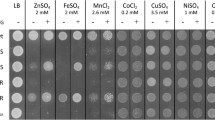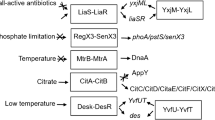Abstract
The CusSR two-component system (TCS) is a copper-sensing apparatus of E. coli that is responsible for regulating the copper-related homeostatic system. The dynamic characteristics of the CusSR network were modified by the introduction of a positive feedback loop. To construct the feedback loop, the CusR, which is activated by the cusC promoter, was cloned downstream of the cusC promoter and reporter protein. The feedback loop system, once activated by environmental copper, triggers the activation of the cusC promoter, which results in the amplification of a reporter protein and CusR expression. The threshold copper concentration for the activation of the modified CusSR TCS network was lowered from 2,476.5 μg/l to 247.7 μg/l, which indicates a tenfold increase in sensitivity. The intensity of the output signal was increased twofold, and was maintained for 16 h. The strategy proposed in this study can also be applied to modify the dynamic characteristics of other TCSs.






Similar content being viewed by others
References
Antsaklis PJ, Michel AN (2005) Linear systems. Corrected edition. edn. Birkhäuser, Boston
Balázsi G, Barabási A-L, Oltvai ZN (2005) Topological units of environmental signal processing in the transcriptional regulatory network of Escherichia coli. Proc Natl Acad Sci USA 102(22):7841–7846
Chang D-E, Leung S, Atkinson MR, Reifler A, Forger D, Ninfa AJ (2009) Building biological memory by linking positive feedback loops. Proc Natl Acad Sci USA
DiGiuseppe PA, Silhavy TJ (2003) Signal detection and target gene induction by the CpxRA two-component system. J Bacteriol 185(8):2432–2440
Farmer WR, Liao JC (2000) Improving lycopene production in Escherichia coli by engineering metabolic control. Nat Biotechnol 18(5):533–537
Kasahara M, Nakata A, Shinagawa H (1992) Molecular analysis of the Escherichia coli phoP-phoQ operon. J Bacteriol 174(2):492–498
Kato A, Tanabe H, Utsumi R (1999) Molecular characterization of the PhoP-PhoQ two-component system in Escherichia coli K-12: identification of extracellular Mg2+−responsive promoters. J Bacteriol 181(17):5516–5520
Laub MT, Goulian M (2007) Specificity in two-component signal transduction pathways. Annu Rev Genet 41(1):121–145
Mascher T, Helmann JD, Unden G (2006) Stimulus perception in bacterial signal-transducing histidine kinases. Microbiol Mol Biol Rev 70(4):910–938
Miller WG, Leveau JH, Lindow SE (2000) Improved gfp and inaZ broad-host-range promoter-probe vectors. Mol Plant Microbe Interact 13(11):1243–1250
Miyashiro T, Goulian M (2008) High stimulus unmasks positive feedback in an autoregulated bacterial signaling circuit. Proc Natl Acad Sci 105(45):17457–17462
Munson GP, Lam DL, Outten FW, O’Halloran TV (2000) Identification of a copper-responsive two-component system on the chromosome of Escherichia coli K-12. J Bacteriol 182(20):5864–5871
Nguyen T, Hong S (2008) Whole genome-based phylogenetic analysis of bacterial two-component systems. Biotechnol Bioprocess Eng 13(3):288–292
Nguyen T, Hong S (2009) Construction and comparative analysis of two-component system and metabolic network profile based phylogenetic trees. Biotechnol Bioprocess Eng 14(2):129–133
Otto K, Silhavy TJ (2002) Surface sensing and adhesion of Escherichia coli controlled by the Cpx-signaling pathway. Proc Natl Acad Sci 99(4):2287–2292
Salis H, Tamsir A, Voigt C (2009) Engineering bacterial signals and sensors. Contrib Microbiol 16:194–225
Savageau MA (1974) Comparison of classical and autogenous systems of regulation in inducible operons. Nature 252(5484):546–549
Shin D, Lee E-J, Huang H, Groisman EA (2006) A positive feedback loop promotes transcription surge that jump-starts Salmonella virulence circuit. Science 314(5805):1607–1609
Stock AM, Robinson VL, Goudreau PN (2000) Two-component signal transduction. Annu Rev Biochem 69:183–215
Williams CL, Cotter PA (2007) Autoregulation is essential for precise temporal and steady-state regulation by the Bordetella BvgAS phosphorelay. J Bacteriol 189(5):1974–1982
Yamamoto K, Ishihama A (2005) Transcriptional response of Escherichia coli to external copper. Mol Microbiol 56(1):215–227
Acknowledgments
This work was supported by a grant from the Next-Generation BioGreen 21 Program (SSAC, grant number PJ008057), Rural Development Administration, Republic of Korea.
Author information
Authors and Affiliations
Corresponding author
Additional information
Sambandam Ravikumar and Van Dung Pham contributed equally to this work.
Electronic supplementary material
Below is the link to the electronic supplementary material.
Rights and permissions
About this article
Cite this article
Ravikumar, S., Pham, V.D., Lee, S.H. et al. Modification of CusSR bacterial two-component systems by the introduction of an inducible positive feedback loop. J Ind Microbiol Biotechnol 39, 861–868 (2012). https://doi.org/10.1007/s10295-012-1096-y
Received:
Accepted:
Published:
Issue Date:
DOI: https://doi.org/10.1007/s10295-012-1096-y




